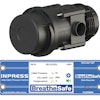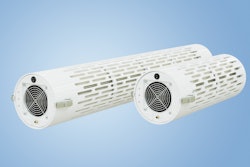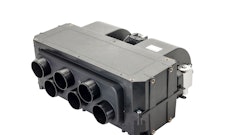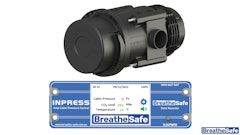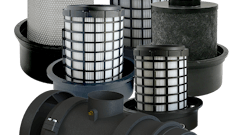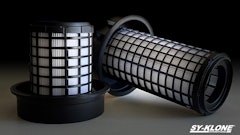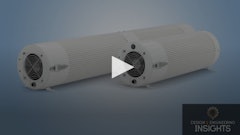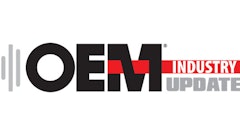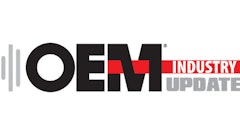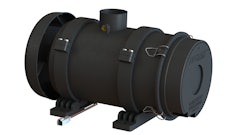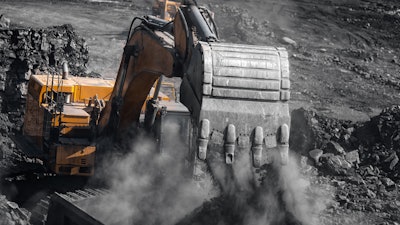
Ensuring operator health remains an integral part of the design process for OEMs in the on- and off-highway mobile equipment industry. “The principal trend we're seeing that is also a major challenge for the industry is how to address operator health risks,” says Amy Rice, CEO of Sy-Klone International. “There is harmful respirable particulate matter in almost all of the major work sites that contribute to our global industrial economy.”
As such, Sy-Klone and other filtration manufacturers like it continue to work with OEMs to develop cab air quality systems which prevent harmful particulates from contaminating the operator cab. Doing so not only ensures the safety of machine operators but also improves their comfort and productivity throughout the workday.
In addition, properly managing air quality helps to minimize machine maintenance issues by preventing dust and debris exposure to sensitive components and systems.
“Sy-Klone is partnering with OEMs to proactively design systems for machines and help retrofit heavy equipment already in the field with air quality solutions for cabs to keep machine operators safe and worksites productive,” says Rice.
To provide OEMs and machine owners with the ability to monitor cab air quality, Sy-Klone is introducing a new family of monitoring systems, the RESPA Advisor for pressure monitoring and RESPA Advisor+ to monitor CO2 and pressure. Both provide audible and visual alarms as well as filter life tracking capabilities.
“The RESPA Advisor monitoring system allows OEMs to offer end users a more holistic air quality solution,” says Rice. “With both in-cab monitoring and remote data download capabilities, this integrated solution can become a key tool in work site health and safety programs.”
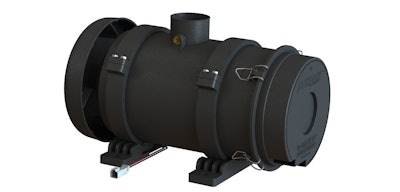 Sy-Klone's RESPA system features monitoring capabilities to ensure it is properly filtering cab air.Sy-Klone International
Sy-Klone's RESPA system features monitoring capabilities to ensure it is properly filtering cab air.Sy-Klone International
HEPA filters trap the smallest of particles
Rice notes that when it comes to filter technology, not all are created equal. There are even differences between the range of HEPA (high-efficiency particulate air) filters available in the market. In the case of Sy-Klone’s HEPA classified RadialSHIELD filters, she says they arrest more than 99.95% of particles at 63 nanometers (nm) or 0.063 micrometers. “The diameter of a human hair is about 100,000 times larger than a 63-nm particle. So, we're talking really small airborne particles.
“When running the HEPA classified RadialSHIELD filters on the intake and recirculation airflows, we consistently see average dust concentration well below 10ug/m3 which allows for standard and regulatory compliance," she adds.
Developing filters which can remove the smallest of particles is vital to ensuring dust and dirt does not enter the operator cab of off-road equipment. And this has become even more critical with the spread of COVID-19 across the globe. “The COVID-19 particle ranges in size between 60 and 140 nm,” says Rice. “It is tiny, so to have solutions that reliably arrest particles that small is a challenge the industry is going to have to rise to meet.
“COVID-19 has elevated the importance and the awareness of the cleanliness of the air we breathe and thinking about what may be airborne that we can’t see, and if it is harmful to us,” she says. “The market is more focused now and it is a great time to be addressing air quality solutions because it is top of mind for [everyone].”
In early 2020, Webasto introduced its HFT 300 and HFT 600 high-efficiency air cleaners to help address the potential spread of diseases like COVID-19 in enclosed areas, including vehicle and equipment cabs. Matthew Wheeler, Head of HVAC Light & Medium Duty at Webasto, says development of the new air cleaners originated in Europe for ambulance and emergency response customers requesting a medical-grade filtration system.
The air cleaners use medical-grade HEPA-14 filtration media which the Centers for Disease Control (CDC) and World Health Organization (WHO) recommends, especially for ambulances and other vehicles transporting COVID patients says Wheeler.  A high velocity, high quality fan moves a significant volume of air through the HEPA-14 filters in Webasto's HFT air cleaners.Webasto
A high velocity, high quality fan moves a significant volume of air through the HEPA-14 filters in Webasto's HFT air cleaners.Webasto
He notes there are many technologies and methods for cleaning air or reducing the spread of a virus in small environments. For the HFT cleaners, Webasto partnered with a filtration company to utilize existing medical-grade filter technology that can be packaged for rapid production and easy installation in multiple locations.
Webasto’s solution is a cylindrical shaped air filter with a high-velocity, high-quality fan that moves a significant volume of air through the HEPA-14 filters, explains Wheeler. “We’re providing a standalone method of getting air filtering around, recirculating air in closed compartments and then trapping 99.97% of the particles that pass through that filter.”
Wheeler says one of the unique features is the ability to use the air cleaners in conjunction with other types of systems designed to control infectious airborne diseases. This is particularly beneficial for vehicles which may transport several people at a time such as a city bus. “The CDC and WHO recommends a lot of air change, a lot of air circulation in a confined space,” he says.
Although a UV lighting or other disease-fighting technology may have been added to an existing HVAC (heating, ventilation and cooling) system on a bus, there would typically not be enough airflow to reduce the risk of airborne contamination, says Wheeler. “You really need to supplement that. And our solution allows you to [do that].” Depending on the existing systems being used and the size of the vehicle, one or several air cleaners can be added.
Because they are a standalone unit, the air cleaners will not affect operation of existing air systems. This along with their compact size allows the air cleaners to be installed in multiple locations on a vehicle, as well.
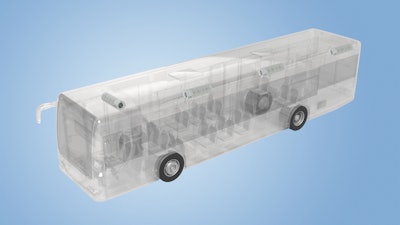 Webasto's HFT air cleaners can be used with other types of air systems to control the spread of airborne diseases.Webasto
Webasto's HFT air cleaners can be used with other types of air systems to control the spread of airborne diseases.Webasto
New ISO standard looks to improve cab air quality
The International Organization for Standardization (ISO) has created a new cab air quality standard for mining equipment, ISO 23875. “This particular standard is designed to protect machine operators from harmful respirable particulates that are found outside of the cab in mining environments,” says Jeff Moredock, Chair, ISO TC-82 Mining Working Group 9, and EVP at Sy-Klone International.
Development of the new standard came about in part due to the need for a singular, global standard. This helps to ensure the health and safety of workers around the world, as well as makes it easier for OEMs to develop machinery for the global market.
Previously, Moredock says each country or region may have had its own standard to follow which required an OEM to develop a different cab for each market. This is time consuming and costly. “Our goal throughout the entire project has been to reach out to all the stakeholders in the world—end users, operators, the industrial hygiene community and the OEMs,” he says, to get their input and ensure the new standard meets everyone’s needs.
There are five key aspects on which the new standard focuses:
- Maintaining defined carbon dioxide (CO2) levels: The maximum allowable CO2 is the external environment CO2 plus 400 parts per million (ppm).
- Recirculation efficiency: Maximum respirable particulate matter concentration of ≤25 micrograms per cubic meter of air at the start and end of decay test, with a maximum of 120 seconds decay time.
- Increased filter-efficiency requirements: A filter must meet more stringent test criteria; typically an ISO 15 E or ISO 35 H HEPA filter will be required in compliant operator enclosures.
- System maintains cab pressurization: Minimum sustained pressurization, when the machine starting device moves to the ‘on’ position shall be ≥20 Pa, maximum sustained pressure shall not exceed 200 Pa.
- Real-time operator cab monitoring: Cab pressurization and CO2 levels monitored by permanently installed monitoring system.
Moredock says the real-time monitoring is a significant aspect of the standard to ensure the health and safety of machine operators. If it detects any issues with pressurization or CO2 levels, it will sound an alarm to alert the operator so corrective actions can be taken.
Another important aspect is the fact the standard is applicable from design or retrofit of a machine all the way through until it is retired. “It is a lifecycle standard,” he says. “The operator enclosure is delivered after being designed, manufactured and performance tested in compliance with the standard. The OEM is responsible for developing a comprehensive operator's maintenance manual which transfers responsibility for the ongoing maintenance to the owner of the machine. The maintenance manual contains a documented maintenance process which includes regular performance testing throughout the lifecycle of the operator enclosure.
“The same testing done at the factory can be done by the maintenance person, the industrial hygienists, or anybody downstream to validate the maintenance protocols are providing the same level of performance as when the machine was originally purchased,” says Moredock.
While the standard was developed for the mining industry, he says it is as useful and effective on all operator enclosures, regardless of industry.
Watch our interview with Jeff Moredock to learn more about the new ISO cab air quality standard.
Technology will play a critical role going forward
As with any machine system, continued technology development and implementation will help improve safety and productivity. Sy-Klone's RESPA Advisor family of monitors is an example of these efforts. Moredock says the new ISO 23875 includes recommendations for monitoring ideas in addition to the now-standardized monitoring capabilities. This was done to help stimulate innovation in the industry and see what could be developed. “There's lots of opportunity here, in terms of technology development, and we're very excited to see what will come in operator enclosure performance,” he says.
Monitoring technology is becoming more commonplace in cab air quality systems, just as it is in other machine systems. The Webasto HFT air cleaners include a monitoring system which monitors pressure drop through the filter system. As the filter fills up with particulate matter, sensing technology determines when there is a pressure drop and turns on a light which is used to indicate it is time to change the filter, says Wheeler.
MANN+HUMMEL has introduced a smart filter monitoring technology which uses various sensors to monitor load status of cab air and other machine filters. Data collected from the sensors is transferred to the cloud for analysis, and a solution is then sent to customers based on this analysis. The goal of this system is to aid with predictive maintenance and reduce unplanned downtime. 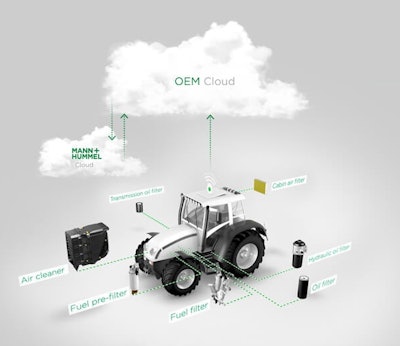 MANN+HUMMEL has developed a smart filter monitoring system which uses various sensors to monitor load status of cab air and other machine filters.MANN+HUMMEL
MANN+HUMMEL has developed a smart filter monitoring system which uses various sensors to monitor load status of cab air and other machine filters.MANN+HUMMEL
Sy-Klone was recently awarded a contract by the National Institute for Occupational Health and Safety (NIOSH) to research the application of smart technology to manage air quality in a machine operator enclosure as a means of improving health and safety.
“Smart technology drives efficiency,” says Rice. “It makes data more available which allows for better monitoring, better business decisions, and ultimately healthier operators and a lower cost base.
“I see more smart technology, more real-time feedback from the systems both for the operator and site management. As safety standards are elevated, OEMs and industry players are going to be looking for high-quality solutions that integrate into an increasingly high-tech business model,” she concludes.



